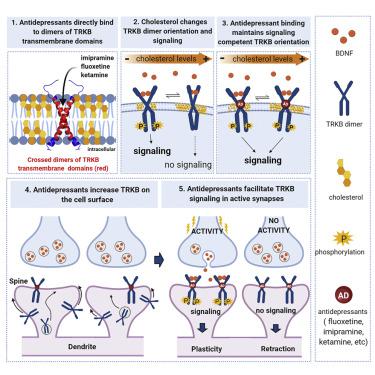Cell ( IF 64.5 ) Pub Date : 2021-02-18 , DOI: 10.1016/j.cell.2021.01.034 Plinio C Casarotto 1 , Mykhailo Girych 2 , Senem M Fred 1 , Vera Kovaleva 3 , Rafael Moliner 1 , Giray Enkavi 2 , Caroline Biojone 1 , Cecilia Cannarozzo 1 , Madhusmita Pryiadrashini Sahu 1 , Katja Kaurinkoski 1 , Cecilia A Brunello 1 , Anna Steinzeig 1 , Frederike Winkel 1 , Sudarshan Patil 4 , Stefan Vestring 5 , Tsvetan Serchov 6 , Cassiano R A F Diniz 7 , Liina Laukkanen 1 , Iseline Cardon 8 , Hanna Antila 9 , Tomasz Rog 2 , Timo Petteri Piepponen 10 , Clive R Bramham 4 , Claus Normann 11 , Sari E Lauri 12 , Mart Saarma 3 , Ilpo Vattulainen 13 , Eero Castrén 1

|
It is unclear how binding of antidepressant drugs to their targets gives rise to the clinical antidepressant effect. We discovered that the transmembrane domain of tyrosine kinase receptor 2 (TRKB), the brain-derived neurotrophic factor (BDNF) receptor that promotes neuronal plasticity and antidepressant responses, has a cholesterol-sensing function that mediates synaptic effects of cholesterol. We then found that both typical and fast-acting antidepressants directly bind to TRKB, thereby facilitating synaptic localization of TRKB and its activation by BDNF. Extensive computational approaches including atomistic molecular dynamics simulations revealed a binding site at the transmembrane region of TRKB dimers. Mutation of the TRKB antidepressant-binding motif impaired cellular, behavioral, and plasticity-promoting responses to antidepressants in vitro and in vivo. We suggest that binding to TRKB and allosteric facilitation of BDNF signaling is the common mechanism for antidepressant action, which may explain why typical antidepressants act slowly and how molecular effects of antidepressants are translated into clinical mood recovery.
中文翻译:

抗抑郁药物通过直接结合 TRKB 神经营养因子受体发挥作用
目前尚不清楚抗抑郁药物与其靶标的结合如何产生临床抗抑郁作用。我们发现酪氨酸激酶受体 2 (TRKB) 的跨膜结构域,即促进神经元可塑性和抗抑郁反应的脑源性神经营养因子 (BDNF) 受体,具有胆固醇感应功能,可介导胆固醇的突触效应。然后我们发现典型的和速效的抗抑郁药都直接与 TRKB 结合,从而促进了 TRKB 的突触定位及其被 BDNF 激活。包括原子分子动力学模拟在内的广泛计算方法揭示了 TRKB 二聚体跨膜区域的结合位点。TRKB 抗抑郁药结合基序的突变损害了对抗抑郁药的细胞、行为和可塑性促进反应体外和体内。我们认为与 TRKB 的结合和 BDNF 信号的变构促进是抗抑郁作用的常见机制,这可以解释为什么典型的抗抑郁药作用缓慢以及抗抑郁药的分子效应如何转化为临床情绪恢复。



























 京公网安备 11010802027423号
京公网安备 11010802027423号